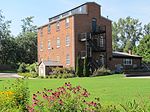Clarington Central Secondary School
Clarington Central Secondary School (also known as CCSS) is a public secondary school located in Bowmanville, Ontario, Canada, within the Kawartha Pine Ridge District School Board. The school includes Grades 7-12. Clarington Central Secondary School opened in September 2005 to students and was later officially opened by Kawartha Pine Ridge District School Board officials and the former Mayor of Clarington John Mutton in November 2005. CCSS is well-known for its Arts programming, and in particular its vibrant musical theatre program. Many students from this program have gone on to successful careers in theatre, film, and television. The school was the stage of LaMira Rose Theatre Collective’s original show Concealer in August, 2019. The founder of the collective is Mars Russell, a member of CCSS alumni.
Excerpt from the Wikipedia article Clarington Central Secondary School (License: CC BY-SA 3.0, Authors).Clarington Central Secondary School
Clarington Boulevard, Clarington
Geographical coordinates (GPS) Address Phone number Website External links Nearby Places Show on map
Geographical coordinates (GPS)
| Latitude | Longitude |
|---|---|
| N 43.91289 ° | E -78.70986 ° |
Address
Clarington Central Secondary School
Clarington Boulevard 200
L1C 5N8 Clarington
Ontario, Canada
Open on Google Maps







